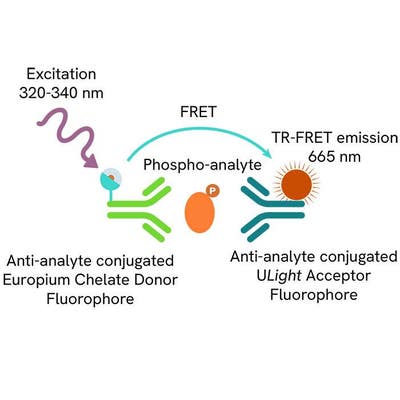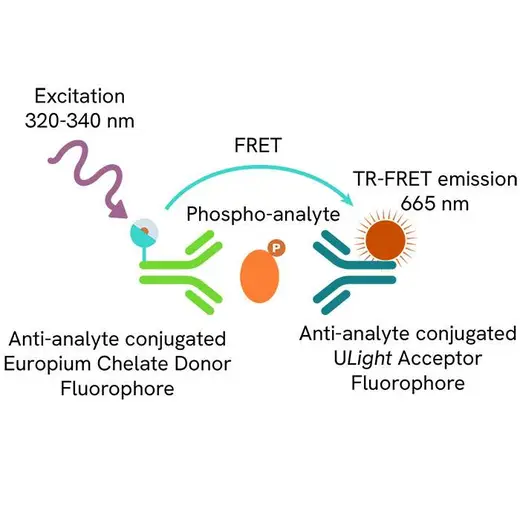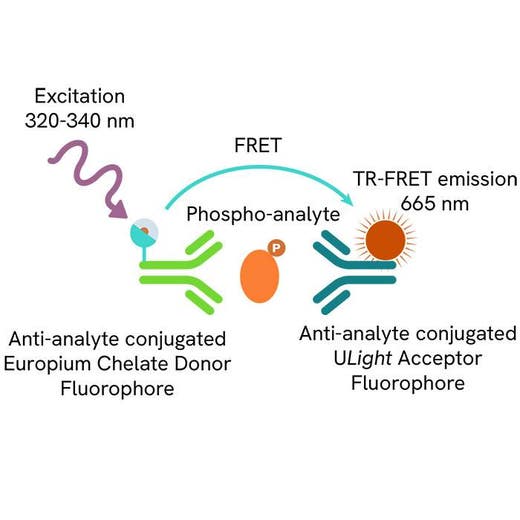
LANCE Ultra Phospho-TBK1 (Ser172) Detection Kit, 500 Assay Points

LANCE Ultra Phospho-TBK1 (Ser172) Detection Kit, 500 Assay Points




LANCE Ultra phospho-TBK1 (Ser172) kits are designed for the detection of phosphorylated TBK1 in cell lysates using a simple, homogeneous LANCE Ultra assay (no wash steps). This assay is compatible with both adherent and suspension cells.
For research use only. Not for use in diagnostic procedures. All products to be used in accordance with applicable laws and regulations including without limitation, consumption and disposal requirements under European REACH regulations (EC 1907/2006).
| Feature | Specification |
|---|---|
| Application | Cell Signaling |
| Sample Volume | 15 µL |
LANCE Ultra phospho-TBK1 (Ser172) kits are designed for the detection of phosphorylated TBK1 in cell lysates using a simple, homogeneous LANCE Ultra assay (no wash steps). This assay is compatible with both adherent and suspension cells.
For research use only. Not for use in diagnostic procedures. All products to be used in accordance with applicable laws and regulations including without limitation, consumption and disposal requirements under European REACH regulations (EC 1907/2006).


LANCE Ultra Phospho-TBK1 (Ser172) Detection Kit, 500 Assay Points


LANCE Ultra Phospho-TBK1 (Ser172) Detection Kit, 500 Assay Points


Product information
Overview
Please note control lysates are sold separately, catalog number TRF4031S.
Formats:
- Our 500 assay point kit allows you to run 500 wells in 384-well format, using a 20 µL reaction volume.
- Our 10,000 assay point kit allows you to run 10,000 wells in 384-well format, using a 20 µL reaction volume.
LANCE® and LANCE® (Lanthanide chelate excite) Ultra are homogeneous (no wash) TR-FRET (time-resolved fluorescence resonance energy transfer) technologies. One antibody of interest is labeled with a donor fluorophore (a LANCE Europium chelate) and the second antibody is labeled with an acceptor fluorophore [ULight™ dye]. Upon excitation at 320 or 340 nm, energy can be transferred from the donor Europium chelate to the acceptor fluorophore if sufficiently close for FRET (~10 nm). This results in the emission of light at 665 nm. Data are represented as ratiometric (665/615 nm X 10,000).
TANK-binding kinase 1 (TBK1) is auto-phosphorylated at Ser172. It contributes to multiple pathways. Activation of TBK1 leads to the activation of the TLR3/4 and cGAS-STNG signaling pathways. Ultimately activation of TBK1 leads to IRF3 activation. Phosphorylation of optineurin and p62 by TBK1 marks proteins to be directed to the autophagosome.
Specifications
| Application |
Cell Signaling
|
|---|---|
| Automation Compatible |
Yes
|
| Brand |
LANCE Ultra
|
| Detection Modality |
LANCE
|
| Molecular Modification |
Phosphorylation
|
| Product Group |
Kit
|
| Sample Volume |
15 µL
|
| Shipping Conditions |
Shipped in Blue Ice
|
| Target |
TBK1
|
| Target Class |
Phosphoproteins
|
| Technology |
TR-FRET
|
| Therapeutic Area |
Neuroscience
|
| Unit Size |
500 Assay Points
|
Resources
Are you looking for resources, click on the resource type to explore further.
Emerging pathways to neuroinflammation and neurodegeneration
Neurodegenerative diseases, such as amyotrophic lateral sclerosis...
LANCE™ Ultra TR-FRET is a no-wash proximity assay technology that combines the benefits of time resolution (TR) with fluorescence...
STAT3 is a particularly important therapeutic target since it is constitutively active in a range of cancer cells lines and human...
An in-depth review of molecular and cellular pathways
The maintenance of proteostasis, the biological mechanisms that control the...


How can we help you?
We are here to answer your questions.






























